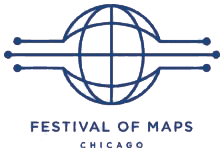European Cartographers and the Ottoman World, 1500–1750: Maps from the Collection of O.J. Sopranos
Explores How Maps Changed the Way We See the World
In conjunction with the city-wide Festival of Maps
November 2, 2007–March 16, 2008

An important collection of early printed maps, atlases, and sea charts that trace the changing view of the Ottoman world from the Age of Discovery to the 18th century will be on exhibit at the Oriental Institute Museum at the University of Chicago, 1155 E. 58th St., from November 2, 2007 to March 16, 2008.
The exhibit, European Cartographers and the Ottoman World, 1500–1750: Maps from the Collection of O. J. Sopranos, is being mounted in conjunction with the Chicago Festival of Maps, a major event beginning in November 2007 that will feature exhibits and programs on cartography at cultural institutions citywide.
- Purchase the exhibit catalogue: European Cartographers and the Ottoman World 1500–1750: Maps from the Collection of O. J. Sopranos
The Oriental Institute exhibit will explore how European cartographers obtained the information that was used for maps and charts of the Ottoman Empire. The era in which the documents were composed (approximately AD 1500–1750) will be placed in its context as an age of exploration when whole new worlds were being opened to Europeans who then documented their “finds” in maps.

“The exhibit opens with the intellectual and geographical discoveries of the fifteenth century that undermined the European medieval view of the cosmos,” said Ian Manners, exhibit curator. “These discoveries began a process whereby cartographers sought to produce and map a new global geography, one that reconciled classical ideas about the world with contemporary information brought back by travelers and voyagers.”
Among the maps on display are several used by mariners as they traveled around the Mediterranean. Others are less utilitarian and virtually pieces of art meant to invoke an idealized vision of a location.
The interest in the birds’ eye views of cities, for instance, a theme of many maps, was an effort to make those places visible and vivid to those who remained at home. Many of the maps are embellished with wonders of these foreign lands; images of the Ottoman sultans, sailing ships, people in their native dress, and exotic animals.

The exhibit explores major influences on mapmaking including the rediscovery of the work of Greek cartographers; the development of portolan (navigation) charts; and reports and narratives from travelers and merchants.
“The rediscovery during the Renaissance of the work of Ptolemy, a geographer who lived in Alexandria during the 2nd century, had a profound impact on map-making,” Manners said. “Ptolemy used coordinates, in effect longitude and latitude, which was a radical departure from the medieval perspective of maps, that were often shaped by religious beliefs.”
The exhibition explored how that rediscovery influenced the development of maps and also addresses what sort of information—accurate, or not—was conveyed by maps, and through what graphic forms, and how perceptions as well as real geographic knowledge of the Ottoman world were conveyed by maps.
The materials also show how cartographers managed to convey a variety of types of information such as city planning, architecture, location of natural resources and trade centers by means of their maps. The exhibit also includes letters from travelers who recorded their own experiences abroad and whose experiences were incorporated into later maps.

Most of the material in the exhibit is from the private collection of Mr. O.J. Sopranos. The Sopranos maps are augmented and complemented by material from the Newberry Library, the University of Chicago Library Special Collections Research Center, and the Walters Art Museum, Baltimore.
The exhibit is accompanied by a full color, lavishly illustrated catalogue authored by Manners, Professor of Geography and Middle Eastern Studies at the University of Texas, Austin, and Pinar Emiralioglu, Visiting Professor, History Department, the University of Pittsburgh.
On Saturday, December 8, the Oriental Institute, in conjunction with the Graham School of the University of Chicago, will host a symposium Mapping the World from Ancient Babylon to the Ottoman Empire that will draw speakers from the region and the nation. For registration information, call (773) 702-9507, or email oi-education@uchicago.edu.
The Oriental Institute Museum is located at 1155 East 58th Street, Chicago. The Museum is open Tuesday, Thursday through Saturday from 10 a.m. to 6:00 p.m., Wednesday from 10:00 a.m. to 8:30 p.m., and Sunday from noon to 6:00 p.m. Suggested donation for admission is $5 for adults, $2 for children. For information, call (773) 702-9514.

